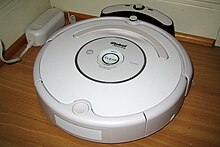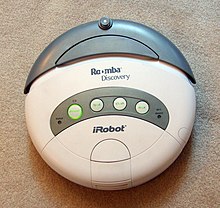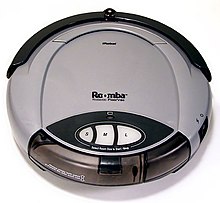Roomba: Difference between revisions
m Bot: links syntax and minor changes |
|||
| Line 80: | Line 80: | ||
== Hacking and extending Roomba == |
== Hacking and extending Roomba == |
||
{{See also|iRobot Create}} |
{{See also|iRobot Create}} |
||
#hack |
|||
Roomba comes with a [[Mini-DIN]] [[Transistor–transistor logic|TTL]] serial interface, which is incompatible with standard PC/Mac serial ports and cables, both electrically and physically. However, third-party adapters [http://www.roombadevtools.com/products/ are available] to access the Roomba's computer via [[Bluetooth]], [[USB]], or [[RS-232]] (PC/Mac serial). New, 500-series, and 410/420 series Roombas upgraded with the [http://store.irobot.com/product/index.jsp?productId=2172890 OSMO hacker] device allow the user to monitor Roomba's many sensors and modify its behavior. The [http://www.roombadevtools.com/docs_roombasci.pdf Roomba Open Interface] (formerly "Roomba Serial Command Interface") [[Application programming interface|API]] allows programmers and roboticists to create their own enhancements to Roomba.<ref>{{cite web|url=http://kibertron.org/sp_pageid=248.php |title=iRobot Corporation: Roomba Open Interface |publisher=Kibertron.org |date=2005-10-24 |accessdate=2009-06-09}}</ref> Several projects are described on Roomba hacking sites. In response to this interest, the company manufactures the [[iRobot Create]], with the vacuum cleaner motor replaced by a "cargo bay" for mounting devices like TV cams, lasers, and even non-mobile robots. The Create provides a greatly enhanced, 25-pin interface providing both [[analog signal|analog]] and [[digital]] bidirectional communication with the hosted device. Thus, it can then be used as the mobile base and wireless interface for [http://www.irobot.com/hrd_right_rail/create_rr/create_fam/createFam_rr_projects.html completely new robots]. |
Roomba comes with a [[Mini-DIN]] [[Transistor–transistor logic|TTL]] serial interface, which is incompatible with standard PC/Mac serial ports and cables, both electrically and physically. However, third-party adapters [http://www.roombadevtools.com/products/ are available] to access the Roomba's computer via [[Bluetooth]], [[USB]], or [[RS-232]] (PC/Mac serial). New, 500-series, and 410/420 series Roombas upgraded with the [http://store.irobot.com/product/index.jsp?productId=2172890 OSMO hacker] device allow the user to monitor Roomba's many sensors and modify its behavior. The [http://www.roombadevtools.com/docs_roombasci.pdf Roomba Open Interface] (formerly "Roomba Serial Command Interface") [[Application programming interface|API]] allows programmers and roboticists to create their own enhancements to Roomba.<ref>{{cite web|url=http://kibertron.org/sp_pageid=248.php |title=iRobot Corporation: Roomba Open Interface |publisher=Kibertron.org |date=2005-10-24 |accessdate=2009-06-09}}</ref> Several projects are described on Roomba hacking sites. In response to this interest, the company manufactures the [[iRobot Create]], with the vacuum cleaner motor replaced by a "cargo bay" for mounting devices like TV cams, lasers, and even non-mobile robots. The Create provides a greatly enhanced, 25-pin interface providing both [[analog signal|analog]] and [[digital]] bidirectional communication with the hosted device. Thus, it can then be used as the mobile base and wireless interface for [http://www.irobot.com/hrd_right_rail/create_rr/create_fam/createFam_rr_projects.html completely new robots]. |
||
Revision as of 11:12, 31 May 2011
This article's lead section may be too short to adequately summarize the key points. (September 2009) |
This article needs additional citations for verification. (May 2009) |

The Roomba is an autonomous robotic vacuum cleaner sold by iRobot. Under normal operating conditions, it is able to navigate a living space and its obstacles while vacuuming the floor. The Roomba was introduced in 2002;[1] as of January 2008[update], iRobot claims that over 2.5 million units have been sold. Several updates and new models have since been released that allow the Roomba to better negotiate obstacles and optimize cleaning. In 2010, Roomba sales went global, and in February 2011, iRobot CEO stated "We have sold more than 6 million home robots worldwide."[2]
Description

All models are disc-shaped, 34 cm (13.4") in diameter and less than 9 cm (3.5") high. A large contact-sensing bumper is mounted on the front half of the unit, with an omnidirectional infrared sensor at its top front center. A carrying handle is fitted on the top of most units.
There have been three generations of Roomba units: The first generation, the second-generation "Discovery" series; and the newest third-generation 500, 600 and 700 Series.
All versions of the Roomba utilize a pair of brushes, rotating in opposite directions, to pick up debris from the floor. The brushes are then followed by a squeegee vacuum, by which the airflow is directed through a narrow slit to increase its velocity, in order to collect fine dust. A horizontally-mounted brush on the right side of the unit sweeps against walls to reach debris not accessible by the main brushes and vacuum. In the first generation of robots, the dirty air passes through the fan before reaching the filter, while later models use a fan-bypass vacuum.
The Roomba operates with internal nickel-metal hydride batteries (NiMH) and must be recharged regularly from a wall plug, although newer second and third-generation models have a self-charging homebase they automatically try to find (via its infrared beacons). Charging on the homebase takes about three hours. All second and most third-generation Roombas can be used with the homebase, even if they do not come packaged with it. First and second-generation models came packaged with a twelve-hour charger, although an optional 2.7-hour Rapid Charger was sold by iRobot to charge batteries externally from the robot.
Four infrared sensors on the bottom of the unit's Bumper prevent it from falling off ledges. Most second- and third-generation models have acoustic-based dirt sensors that allow them to detect particularly dirty spots (zones having excess particulates) and focus on those areas accordingly. Some 500 series robots also include a radio-frequency transmitter/receiver for use with Virtual Wall Lighthouses. This feature is now only available on the higher end 500 and 700 series robots.
iRobot has released several types of bins for the 500 Series robots. The standard "Vacuum Bin" uses the separate squeegee vacuum as with all prior models. The "High Capacity Sweeper Bin" does not include a vacuum, but has greater capacity for debris collected by the brushes. The "Aerovac" bin directs airflow through the main brushes instead of using a squeegee.
Operation

All Roomba models can be operated by manually carrying them to the room to be cleaned, and pressing the appropriate button. First-generation models needed to be told the size of the room via three room size buttons (Small, Medium, and Large), but this is no longer required with later models, which automatically estimate room size and adjust cleaning time accordingly.
Second- or third-generation Roombas introduced several new operating modes. "Clean" mode is the normal cleaning program, starting in a spiral and then following a wall, until the room is determined to be clean. "Spot" mode cleans a small area, using a spiral pattern. "Max" runs the standard cleaning algorithm until the battery is depleted. "Dock" mode, introduced with the third generation, instructs the robot to seek a self-charging Home base and recharge itself. The availability of the modes varies depending on model, generally with higher-end units having more features.
A second generation Roomba may also be used with the Scheduler accessory. It allows the Roomba to begin cleaning automatically at the time of day that the owner desires. This can be useful for people who want the Roomba to clean while they are at work. Most 500 Series robots support scheduling through buttons on the unit itself, and higher-end models allow the use of a radio-frequency remote to program schedules.
The robot's bumper detects bumping into walls and furniture, and the Virtual Walls project infrared beams which the Roomba will not cross. Special Scheduler Virtual Walls can be programmed to turn on at the same time the Scheduler-enabled Roomba is activated.
Unlike the Electrolux Trilobite vacuuming robots, Roombas do not map out the rooms they are cleaning. Instead, they rely on a few simple algorithms such as spiral cleaning (spiraling), room crossing, wall-following and random walk angle-changing after bumping into an object or wall. This design is based on MIT researcher and iRobot CTO Rodney Brooks' philosophy that robots should be like insects, equipped with simple control mechanisms tuned to their environments. The result is that although Roombas are effective at cleaning rooms, they take several times as long to do the job as a person would. The Roomba may cover some areas many times, and other areas only once or twice.
After a period of time cleaning, the Roomba stops and sings a few triumphant notes. The cleaning time depends on room size and, for newer models, volume of dirt. First-generation models must be told the room size, while third-generation models estimate room size by measuring the longest straight-line run they can perform without bumping into an object. After cleaning, if a home base is detected a second or third-generation Roomba will try to return to it. While in contact with the home base, a Roomba will charge its battery. With the exception of the first-generation Roomba, an infrared remote control can also be used to control the unit, which is useful for a disabled person.
General maintenance of the robot consists of emptying the debris bin and cleaning the filter, as well as cleaning the brushes. Excessive hair accumulation in the brush system can cause the brushes to stall and/or overheat, damaging the unit.
The Roomba is not designed for deep-pile carpet. The first and second-generation Roombas would get stuck on rug tassels (though they could be tucked under for running a Roomba) and electrical cords. The third generation is able to reverse its brushes to escape entangled cords and tassels. It is low enough to go under a bed or other furniture. If at any time the unit senses that it has become stuck, no longer senses the floor beneath it, or it decides that it has worked its way into a narrow area from which it is unable to escape, it stops and sounds an error to help its owner find it.
The third-generation Roomba, which moves faster than previous Roombas, has infrared sensors in its bumper to detect obstacles. The robot then slows down when nearing obstacles to reduce its force of impact.
Models

Introduced in 2002, the first-generation Roomba had three buttons for room size. The first generation units comprise the original, silver-colored Roomba, the blue Roomba Pro, and the maroon Roomba Pro Elite. The latter two models included additional accessories, but all three use the same overall core robot and cleaning system.
The second-generation Roombas (dubbed "Discovery") replaced their predecessors in July 2004, adding a larger dust bin, better software that calculates room sizes, fast charging in the home base (or wall hanger in the Discovery SE), and dirt detection. All second-generation Roombas are functionally identical, though some have more or fewer buttons, accessories, or external designs. A version with updated software and a new front wheel, "2.1" was issued in 2005, and the update was made available to existing units as well. The low-end models continue to be available as of 2007 with new, three-digit model names.
The third-generation 5xx Roomba was introduced in 2007 and features an infrared sensor to detect obstacles and reduce speed, a dock button, and improved mechanical components.[3]
Roomba Budget models (Dirt Dog and Model 401) have a simplified interface (a single "Clean" button) and lack some of the program generated flexibility of other versions. They are positioned to be less expensive versions of the Roomba for first-time purchasers. The Roomba Dirt Dog contains sweeping brushes and a larger dust bin but lacks the vacuum motor. It uses the space required for the vacuum for additional dust bin volume. It is designed for home shop or home garage environments. The Roomba Model 401 is similar but has a 'standard' size dust bin and vacuum system. They are compatible with the extended-life batteries, fast charger and schedulers of the Discovery series.
In January of 2011, iRobot announced the Roomba 700 Series robot.[4]. Although largely similar to the 500 Series robots, the 700 series features a more robust cleaning system and improved battery life, among other small improvements. The robot began shipping in spring 2011.
Accessories
- Easy Clean Brush: A brush that is designed specifically for cleaning pet hair, and being easier to clean off (standard on "for pets" models).
- Remote Control: Allows the owner to control the Roomba remotely (works with all second and third generation Roombas).
- iRobot Scheduler: Allows the owner to program the Roomba to clean at certain times automatically. Schedule Upgrade accessory will also update a pre-2.1 Roomba to the 2.1 software (for third generation Roombas).
- Homebase: The Roomba automatically returns to here for recharging (for second and third generation Roombas).
- Virtual Wall: Used for keeping the Roomba out of certain areas (for all Roombas).
- Virtual Wall Lighthouse: Functionality of Virtual Wall in addition to 'Lighthouse' mode which will contain Roomba in one room until the room is completely vacuumed before moving on to the next.
- OSMO: A dongle that attaches to the serial port on the Roomba. This updates a pre-2.1 Roomba's firmware to version 2.1 and can also correct the "circle dance" problem (for all second generation Roombas).
- Advanced Power System (APS) Battery: Rechargeable battery for all Roomba models that holds enough power to clean for 200 minutes.
- Roomba Serial Control Interface (Roomba SCI) exposes all the functionalities and sensor information from the iRobot Roomba vacuum cleaner. Using the Roomba SCI a roboticist can command and control the Roomba by interfacing to the 7pin Mini Din UART port.
- Roo series of products: RooTooth, RooStick and Roo232 by RoboDynamics
- RooTooth: A Bluetooth module that converts the Roomba to Bluetooth control from any bluetooth device.
- RooStick: A Bluetooth dongle to allow control from BlueTooth enabled devices
- Roo232: Allows programming input through a serial port connector.
- RoombaFX - A C# class by RoboDynamics that implements the entire Roomba SCI command set. Available on Source Forge for download and your contributions.[5]
Hacking and extending Roomba
- hack
Roomba comes with a Mini-DIN TTL serial interface, which is incompatible with standard PC/Mac serial ports and cables, both electrically and physically. However, third-party adapters are available to access the Roomba's computer via Bluetooth, USB, or RS-232 (PC/Mac serial). New, 500-series, and 410/420 series Roombas upgraded with the OSMO hacker device allow the user to monitor Roomba's many sensors and modify its behavior. The Roomba Open Interface (formerly "Roomba Serial Command Interface") API allows programmers and roboticists to create their own enhancements to Roomba.[6] Several projects are described on Roomba hacking sites. In response to this interest, the company manufactures the iRobot Create, with the vacuum cleaner motor replaced by a "cargo bay" for mounting devices like TV cams, lasers, and even non-mobile robots. The Create provides a greatly enhanced, 25-pin interface providing both analog and digital bidirectional communication with the hosted device. Thus, it can then be used as the mobile base and wireless interface for completely new robots.
See also
- Comparison of domestic robots
- Domestic robot
- Robotic mapping
- Robotics suite
- Scooba floor washer, iRobot's second home robot
- RoboMower lawn mower home robot, manufactured by Friendly Robotics
References
- ^ "iRobot Corporation: Our History".
- ^ http://seekingalpha.com/article/252090-irobot-ceo-discusses-q4-2010-results-earnings-call-transcript?source=yahoo
- ^ "Official iRobot Website". Homesupport.irobot.com. Retrieved 2009-06-09.
- ^ http://www.irobot.com/sp.cfm?pageid=86&id=651&referrer=28
- ^ "RoombaFX beta by bluewhackadoo". Anonymous. Retrieved 13 July 2010.
- ^ "iRobot Corporation: Roomba Open Interface". Kibertron.org. 2005-10-24. Retrieved 2009-06-09.
External links
- iRobot, manufacturer and US retailer of Roombas
- RobotReviews.com, The largest and most active discussion site for Roomba users
- Robotic mapping for Roomba.
- RoombaDevTools.com, provides development tools to use roomba as a robotic base
- C# RoombaSCI, Open Source C# Programming Framework for Roomba
